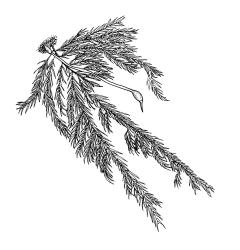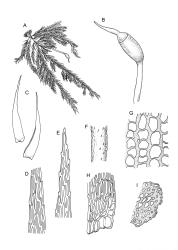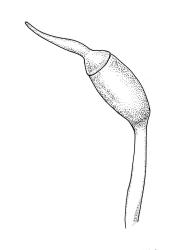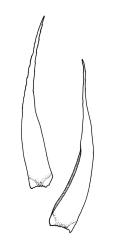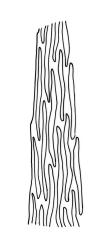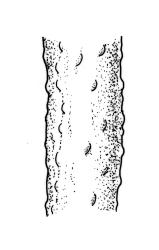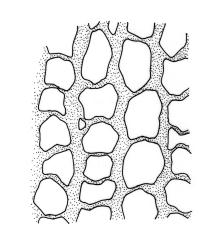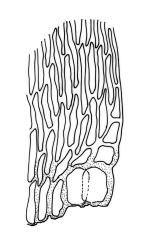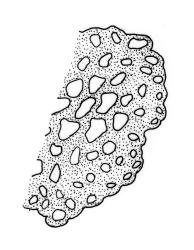- ≡ Hypnum kirkii Müll.Hal. ex Beckett, Trans. & Proc. New Zealand Inst. 25: 294 (1893)
- ≡ Rhaphidostegium kirkii (Müll.Hal. ex Beckett) Broth., Nat. Pflanzenfam. [Engler & Prantl] 1(3), 1110 (1908)
- ≡ Rhaphidorrhynchium kirkii (Müll.Hal. ex Beckett) Broth., Nat. Pflanzenfam., ed. 2 [Engler & Prantl] 11, 427 (1925)
Plants yellow-green, lustrous, apparently ± pendent from substrate. Stems irregularly branched, commonly 10–20 mm, but to at least 30 mm, sparsely beset below with smooth, pale brown rhizoids, in cross-section c. 12–14 cells across, with 4–5 outer layers of very thick-walled and pigmented cells surrounding parenchyma cells, lacking both a central strand and hyaloderm. Branches uneven in length, to at least 7 mm. Leaves moderately homomallous or erect, little altered when dry, narrowly lanceolate with a slender acumen, sharply denticulate by projecting cell ends in upper half, 1.0–1.3 × 0.2–0.3 mm (under coverslip); mid laminal cells (upper third of leaf) linear, mostly 60–75 × c. 4 µm, smooth, porose; cells at leaf base becoming shorter, broader, and more porose and with a pigmented basal band; alar cells abruptly differentiated, usually 2–3 in extreme angles strongly inflated, hyaline, and c. 45 ×15 µm, with supra-alar cells few and irregular.
Apparently autoicous. Perichaetia scattered on stems, the inner perichaetial leaves acuminate from an oblong and ± sheathing base, strongly toothed above. Perigonia not clearly seen. Setae red, twisted weakly to the left when dry, mammillate (sometimes weakly) throughout, 6–8 mm; capsules inclined or ± horizontal due to curvature of setae, oblong-cylindric, with a short neck, ± constricted below the mouth when dry, red-brown when mature, c. 1.2 mm; stomata not seen; operculum slenderly rostrate, c. 1.3 mm, exceeding the length of the capsule; exothecial cells subcollenchymatous and in distinct longitudinal ranks. Peristome as per genus; endostomal membrane high and cilia absent. Calyptra cucullate and smooth. Spores 15–21 µm, green, finely papillose.
Known from Moggy I. (near St), Sol, Sn, and A.
Endemic.
The best documented collection (D. Horning SA65) came from the trunk of "dead & live" Olearia lyallii at the South Promontory of Snares I.; also terrestrial on humus or peat.
This long neglected species vegetatively resembles the widespread S. subhumile var. contiguum and it may prove to be allied to it. However, it is distinguished by several morphological differences, notably the sharply denticulate upper half of the vegetative leaf margins (poorly illustrated here), the mammillate (sometimes variably so) setae and the subcollenchymatous exothecial cells (i.e., with the longitudinal walls markedly thickened, transverse walls relatively thin-walled, and corners not thickened) that are arranged in clear longitudinal ranks. Other differences from S. subhumile var. contiguum are the somewhat longer and more branched stems, a tendency for the leaves to be more erect-appressed, and a tendency for the mid laminal cells (upper third of leaf) to be porose. Collectively, these differences dictate taxonomic distinction at the species level.



